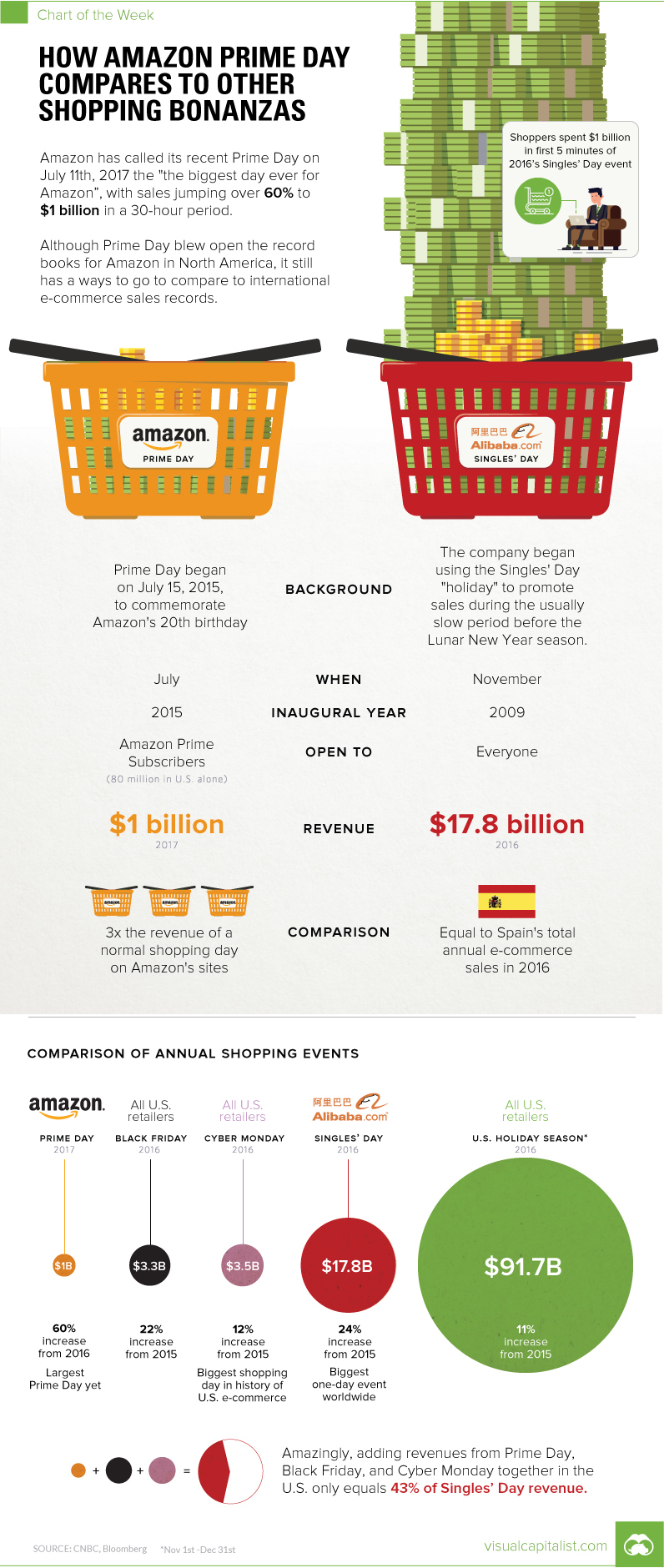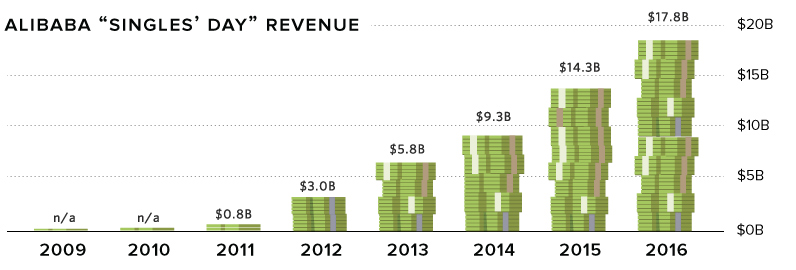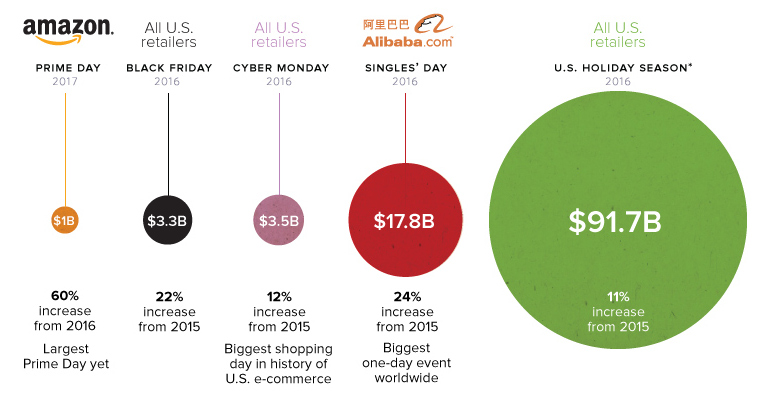Technology
How Amazon Prime Day Compares to Other Shopping Bonanzas

How Amazon Prime Day Compares to Other Shopping Bonanzas
The Chart of the Week is a weekly Visual Capitalist feature on Fridays.
Earlier this week, products were flying off their figurative shelves at a pace that is pretty unusual for the summer. That’s because July 11, 2017 was the third-ever Amazon Prime Day – and in just a 30-hour period, the online retailer was able to offload close to $1 billion of merchandise.
The biggest seller of the day was the Amazon Echo Dot, an entry-level product that allows customers to access the company’s personal voice assistant, Amazon Alexa. With a 30% discount, it outsold thousands of other heavily discounted items, propelling Amazon to a 60% increase in revenue over the previous Prime Day in 2016.
At triple the sales of a normal day, it’s fair to say Amazon Prime Day is big – but just how big, exactly?
How Does Amazon Prime Day Compare?
Set up to reward Amazon’s roughly 80 million Prime subscribers once a year, the $1 billion number is pretty impressive even on a grander scale.
Here are the e-commerce numbers for Black Friday and Cyber Monday for all U.S. retailers in 2016:
| Shopping Day | Retailer | E-commerce sales | % Increase (from prev. year) |
|---|---|---|---|
| Amazon Prime Day (2017) | Amazon | $1 billion (est.) | 60% |
| Black Friday (2016) | All U.S. Retailers | $3.3 billion | 22% |
| Cyber Monday (2016) | All U.S. Retailers | $3.5 billion | 12% |
The fact that Prime Day revenue comes from only one retailer makes it quite impressive – especially considering the day falls in the heat of summer, rather than the holiday shopping season. The 60% growth figure is compelling as well, showing that Prime Day could eventually be the biggest U.S. shopping day of the year.
Singled Out by Alibaba
While Amazon Prime Day favors comparably in the U.S. market, it doesn’t even close when looking at single-day events abroad. That’s because since 2009, Chinese e-commerce leader Alibaba has used the Singles’ Day “holiday” to promote sales during the slow period leading up to the Lunar New Year season.
In 2016, Alibaba raked in a whopping $17.8 billion of revenue from Singles’ Day alone.
See the steady growth of the event below:

The concept of setting a global record for e-commerce sales on Singles’ Day sounds a bit strange to us Westerners, but the hype around Singles’ Day is no joke.
The holiday is now a full-on festival in China, with star-studded ceremonies kicking off the 24-hour sales period. For last year’s event, even Kobe Bryant, David and Victoria Beckham, and band OneRepublic made appearances to help ring it in.
A Prime Opportunity
During just the first five minutes of Singles’ Day in 2016, shoppers spent as much money ($1 billion) as Amazon’s entire 30-hour event in 2017.
While that may seem daunting to match, Jeff Bezos has built his tech empire from taking advantage of big opportunities such as this. As a result, it’s likely that Bezos and Amazon both see Singles’ Day as something to emulate – a full-blown festival that could ring in over $10 billion in revenue in one day for Amazon.
After all, it’s already been done once by Jack Ma, so why can’t it be done again in North America?
Technology
Ranked: Semiconductor Companies by Industry Revenue Share
Nvidia is coming for Intel’s crown. Samsung is losing ground. AI is transforming the space. We break down revenue for semiconductor companies.
Semiconductor Companies by Industry Revenue Share
This was originally posted on our Voronoi app. Download the app for free on Apple or Android and discover incredible data-driven charts from a variety of trusted sources.
Did you know that some computer chips are now retailing for the price of a new BMW?
As computers invade nearly every sphere of life, so too have the chips that power them, raising the revenues of the businesses dedicated to designing them.
But how did various chipmakers measure against each other last year?
We rank the biggest semiconductor companies by their percentage share of the industry’s revenues in 2023, using data from Omdia research.
Which Chip Company Made the Most Money in 2023?
Market leader and industry-defining veteran Intel still holds the crown for the most revenue in the sector, crossing $50 billion in 2023, or 10% of the broader industry’s topline.
All is not well at Intel, however, with the company’s stock price down over 20% year-to-date after it revealed billion-dollar losses in its foundry business.
| Rank | Company | 2023 Revenue | % of Industry Revenue |
|---|---|---|---|
| 1 | Intel | $51B | 9.4% |
| 2 | NVIDIA | $49B | 9.0% |
| 3 | Samsung Electronics | $44B | 8.1% |
| 4 | Qualcomm | $31B | 5.7% |
| 5 | Broadcom | $28B | 5.2% |
| 6 | SK Hynix | $24B | 4.4% |
| 7 | AMD | $22B | 4.1% |
| 8 | Apple | $19B | 3.4% |
| 9 | Infineon Tech | $17B | 3.2% |
| 10 | STMicroelectronics | $17B | 3.2% |
| 11 | Texas Instruments | $17B | 3.1% |
| 12 | Micron Technology | $16B | 2.9% |
| 13 | MediaTek | $14B | 2.6% |
| 14 | NXP | $13B | 2.4% |
| 15 | Analog Devices | $12B | 2.2% |
| 16 | Renesas Electronics Corporation | $11B | 1.9% |
| 17 | Sony Semiconductor Solutions Corporation | $10B | 1.9% |
| 18 | Microchip Technology | $8B | 1.5% |
| 19 | Onsemi | $8B | 1.4% |
| 20 | KIOXIA Corporation | $7B | 1.3% |
| N/A | Others | $126B | 23.2% |
| N/A | Total | $545B | 100% |
Note: Figures are rounded. Totals and percentages may not sum to 100.
Meanwhile, Nvidia is very close to overtaking Intel, after declaring $49 billion of topline revenue for 2023. This is more than double its 2022 revenue ($21 billion), increasing its share of industry revenues to 9%.
Nvidia’s meteoric rise has gotten a huge thumbs-up from investors. It became a trillion dollar stock last year, and broke the single-day gain record for market capitalization this year.
Other chipmakers haven’t been as successful. Out of the top 20 semiconductor companies by revenue, 12 did not match their 2022 revenues, including big names like Intel, Samsung, and AMD.
The Many Different Types of Chipmakers
All of these companies may belong to the same industry, but they don’t focus on the same niche.
According to Investopedia, there are four major types of chips, depending on their functionality: microprocessors, memory chips, standard chips, and complex systems on a chip.
Nvidia’s core business was once GPUs for computers (graphics processing units), but in recent years this has drastically shifted towards microprocessors for analytics and AI.
These specialized chips seem to be where the majority of growth is occurring within the sector. For example, companies that are largely in the memory segment—Samsung, SK Hynix, and Micron Technology—saw peak revenues in the mid-2010s.
-

 Green2 weeks ago
Green2 weeks agoRanked: Top Countries by Total Forest Loss Since 2001
-

 Travel1 week ago
Travel1 week agoRanked: The World’s Top Flight Routes, by Revenue
-

 Technology2 weeks ago
Technology2 weeks agoRanked: Semiconductor Companies by Industry Revenue Share
-

 Money2 weeks ago
Money2 weeks agoWhich States Have the Highest Minimum Wage in America?
-

 Real Estate2 weeks ago
Real Estate2 weeks agoRanked: The Most Valuable Housing Markets in America
-

 Markets2 weeks ago
Markets2 weeks agoCharted: Big Four Market Share by S&P 500 Audits
-

 AI2 weeks ago
AI2 weeks agoThe Stock Performance of U.S. Chipmakers So Far in 2024
-

 Automotive2 weeks ago
Automotive2 weeks agoAlmost Every EV Stock is Down After Q1 2024














